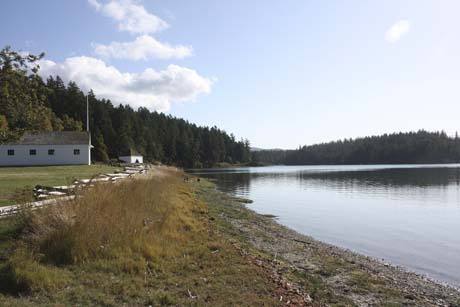This is part 2 of a two-part series about the coastal cutthroat on the San Juan Islands
Little research has been done on coastal cutthroat, and experts want to know more in order to move forward with conservation efforts.
San Juan County is developing a plan for all the salmon, with an emphasis on chinook, but Barbara Rosenkotter said the county is still identifying what fish are in which streams.
“What’s really important is diversity of the species,” said Rosenkotter, San Juan County’s coordinator for salmon recovery.
The county’s goal, is to not to constrain landowners or enforce laws, but to show them how to protect the species on their land. For example, if someone has a stream on their property they can keep the natural vegetation as a buffer zone, which helps promote other native species.
“At this moment there is no specific ordinance for cutthroat,” Rosenkotter said about San Juan’s upcoming Critical Area Ordinance update. “The update will be protecting certain wetlands, buffer zones included, which are accessible to cutthroat and other salmon.”
Mary Lou White, a biologist for the Wild Fish Conservancy, has been working at San Juan Island’s Garrison Bay watershed for almost four years. She has been creating plans to increase water flows with bends in the channels, help a small lake on the property drain slower and create woody debris areas for fish to hide. She also studies what type of vegetation should be in the watershed, and what non-native fish should be removed.
White researched historical documents to find out what the watershed used to look like. She found that in the 1800s the valley was bulldozed to make room for farm land, at least seven ponds were created and that at one time there was even a population of beaver.
White said since those developments, the watershed, which drains from a forested wetland to an agricultural valley used primarily for livestock, hasn’t changed over the last 100 years.
A conservation plan
Although the U.S. Fish and Wildlife Service has no plan to list cutthroat as threatened or endangered, it intends to develop a coastal cutthroat conservation plan.
“Hopefully we can come up with a plan to prevent listing the fish as endangered species,” said Marci Koski, a supervisory fish biologist for recovery assessment and planning.
The plan will focus on recovery and risk assessment by asking land owners about cutthroat populations on their property.
“Cutthroat are really interesting because they occur in so many different environments,” said Koski. “All these different environments have different threats, from-over fishing to habitat degradation.”
Threats
For Barsh, who has collected over 100 hours of film of cutthroats on the islands in the last six years, there is one real threat — humans.
“The bottom line is that there are at least two genetically distinct, isolated cutthroat stocks in the islands,” said Barsh, director of Kwiaht, the Lopez-based Center for the Historical Ecology of the Salish Sea. “Although both are imminently threatened with extinction due chiefly to human factors: modifications of stream courses, water withdrawals and impoundments, introduction of non-native fish species.”
The Wild Fish Conservancy currently needs funding for more research, to track not only cutthroat, but other species vital to the same habitat. Jamie Glasgow, director of the Wild Fish Conservancy, says the decline of cutthroat could indicate the potential decline of other fish like chinook salmon, which are a large part of the resident orca population’s diet.
Glasgow has been mapping streams and fish habitats and collecting data on the San Juan Islands since 2004.
Why care about these fish?
Over the years he has discovered what he calls “logical” and “illogical” ways at looking at the cutthroat. The logical reasons are easy to define —diversity of the species, preserving a natural ecosystem, and recreational fishing.
The reasons he is particularly drawn to the cutthroat are more difficult for him to explain.
“These are beautiful, charismatic animals that would be a tragedy to lose,” said Glasgow. “Just like it’d be a tragedy to lose the Sistine Chapel, even though it is hard to define the actual value of the chapel to society because we don’t eat it, it doesn’t protect us, we could build a replica at Disneyland, et cetera.”
For Glasgow, however you look at the cutthroat, the best way to deal with a mysterious fish is with precautionary steps.
“If you’re not sure, you better be careful,” Glasgow said. “If we don’t have answers, we need to get answers.”




